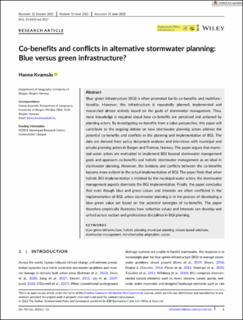Co-benefits and conflicts in alternative stormwater planning: Blue versus green infrastructure?
Journal article, Peer reviewed
Published version

Åpne
Permanent lenke
https://hdl.handle.net/11250/3025640Utgivelsesdato
2022Metadata
Vis full innførselSamlinger
- Department of Geography [627]
- Registrations from Cristin [9489]
Sammendrag
Blue–green infrastructure (BGI) is often promoted for its co-benefits and multifunctionality. However, this infrastructure is repeatedly planned, implemented and researched almost entirely based on the goals of stormwater management. Thus, more knowledge is required about how co-benefits are perceived and actioned by planning actors. By investigating co-benefits from a value perspective, this paper will contribute to the ongoing debate on how stormwater planning actors address the potential co-benefits and conflicts in the planning and implementation of BGI. The data are derived from policy document analyses and interviews with municipal and private planning actors in Bergen and Tromsø, Norway. The paper argues that municipal water actors are motivated to implement BGI beyond stormwater management goals and approach co-benefits and holistic stormwater management as an ideal in stormwater planning. However, the tensions and conflicts between the co-benefits become more evident in the actual implementation of BGI. The paper finds that when holistic BGI implementation is initiated by the municipal water actors, the stormwater management aspects dominate the BGI implementation. Finally, the paper concludes that even though blue and green values and interests are often conflicted in the implementation of BGI, urban stormwater planning is in the process of developing a blue–green value set based on the potential synergies of co-benefits. The paper therefore empirically illustrates how collective values and interests can develop and unfold across sectors and professional disciplines in BGI planning.
